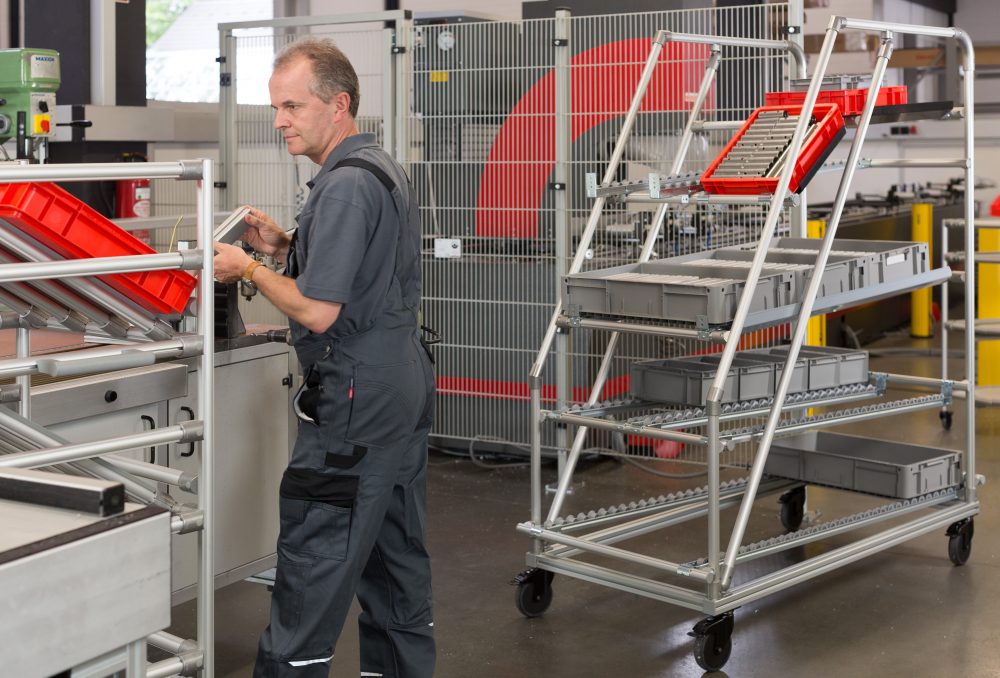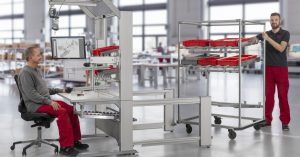Companies that want to know parts are safely stored and in easy reach turn to FIFO as the solution.
Only last week, we emphasised just how important lean principles are for intralogistics. Indeed, there are few other sectors where it is so important to pursue efficiency consistently and at every level. And that is one very good reason to take another look at the special circumstances and continue our journey – with the FIFO method. This method is all about safeguarding material quality, and specifically in storage facilities. If parts are held in storage for too long, numerous problems can arise that do not occur during normal storage, even over long periods of time. This is precisely where the FIFO storage technique comes into play.

What FIFO means
FIFO is an acronym and stands for “first in, first out”. At first glance, the FIFO method seems simple – all the parts that are ordered first are also the first to be taken out of storage and put to use. It is basically no different from the principle that supermarkets use for stacking their shelves. The FIFO process is used in three different instances. Firstly, when one production station works faster than the next one downstream. Secondly, when it is not possible to interlink individual production stages due to technological differences between the processes. And, thirdly, when products are required for several stations.
In all three instances, FIFO defines the sequence of the material flow and a maximum stock level between consecutive processes. It is so important because, when problems are identified, it is easier to trace them back to the place and time of origin and because a predefined maximum stock level will not be exceeded and a fixed sequence is maintained for consumption. Related, but very different systems include LIFO and HIFO. In LIFO (last in, first out) the stored elements are removed in reverse order. Of course, that only makes sense if the relevant parts do not lose value as a result of being in storage. In HIFO (highest in, first out), however, the material that has the highest value is the first to be used.
Using FIFO to tackle material wastage
The principles and concepts of lean production are clear: Material waste of any type is completely contrary to the very core of the Japanese efficiency philosophy. Accordingly, the idea of holding material in storage for as short a period of time as possible fits perfectly with the lean concept. Ultimately, there is no way to guarantee that material will not age, corrode or even get damaged. What’s more, when using a “classic” or even random approach to storage, personnel can’t even see whether parts towards the back are showing signs of these changes. When applying FIFO, issues like these are consigned to the past.

Diving into FIFO
Companies that want to adopt the FIFO process need state-of-the-art material supply systems that will ensure the new parts can be removed easily in line with FIFO principles. Flow racks that are filled from the rear and emptied from the front are ideal. Our tried-and-tested FIFO transport trolleys offer an excellent example of this process in action. Mounted on castors, these mobile racks can be rolled right up to the work bench, thus also providing a material supply system that satisfies the very latest ergonomic standards. It also helps avoid the third muda (unnecessary movement).
The relevant transport containers are inserted into the trolley at one side and slide down an incline to the removal side, as per the flow rack principle. When a container is removed from the rack, the next one in line slides neatly into place. FIFO racks can also be fitted out with practical Kanban roller conveyors, so that fill levels can be identified at a glance and the rack can be restocked with material in good time.





